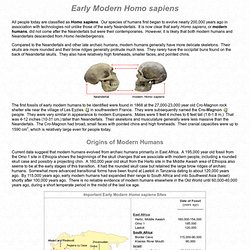

Behavioral Objectives and Rate of Forgetting., 1970. Based on the broader needs for long-term studies of the effects of instructional treatments, for behavioral objectives, and for learning hierarchies, this research investigated differences in the effect on learning and rate of forgetting when students are informed of the behavioral objectives and learning hierarchy.

It was expected that students who were informed of the behavioral objectives of an activity would perform higher on achievement and retention posttests. Nine null hypotheses were tested, using 88 elementary education majors divided into four groups. Students were classified according to their ability levels and each group received different information concerning the use of the self-instructional text material. Posttests were administered immediately on completion of the unit to compare the degree of learning, and after 2 weeks to compare the rate of forgetting.
If Modern Humans Are So Smart, Why Are Our Brains Shrinking? A recent study he conducted with a colleague, Drew Bailey, led Geary to this epiphany.

The aim of their investigation was to explore how cranial size changed as our species adapted to an increasingly complex social environment between 1.9 million and 10,000 years ago. Since that period predates the first alphabets, the researchers had no written record with which to gauge the social milieu of our predecessors. Consequently, the Missouri team used population density as a proxy for social complexity, reasoning that when more people are concentrated in a geographic region, trade springs up between groups, there is greater division of labor, the gathering of food becomes more efficient, and interactions among individuals become richer and more varied.
Bailey and Geary found population density did indeed track closely with brain size, but in a surprising way. When population numbers were low, as was the case for most of our evolution, the cranium kept getting bigger. Current Anthropology, Vol. 44, No. 5 (December 2003), pp. 627-651. The brains of Neanderthals and modern humans developed differently. Researcher at the Max Planck Institute for Evolutionary Anthropology in Leipzig, Germany have documented species differences in the pattern of brain development after birth that are likely to contribute to cognitive differences between modern humans and Neanderthals November 08, 2010 Zoom Image The brains of Neanderthals and modern humans are very similar at the time of birth.

A reconstruction of a Neanderthal... [more] The brains of Neanderthals and modern humans are very similar at the time of birth. The brains of Neanderthals and modern humans are very similar at the time of birth. . © Max Planck Institute for Evolutionary Anthropology Whether cognitive differences exist between modern humans and Neanderthals is the subject of contentious disputes in anthropology and archaeology. Evolution of Modern Humans: Early Modern Homo sapiens. Early Modern Homo sapiens All people today are classified as Homo sapiens.

Our species of humans first began to evolve nearly 200,000 years ago in association with technologies not unlike those of the early Neandertals. It is now clear that early Homo sapiens, or modern humans, did not come after the Neandertals but were their contemporaries. However, it is likely that both modern humans and Neandertals descended from Homo heidelbergensis. Compared to the Neandertals and other late archaic humans, modern humans generally have more delicate skeletons. Their skulls are more rounded and their brow ridges generally protrude much less. Replacement Model Arguments There are two sources of evidence supporting the replacement model--the fossil record and DNA. Homo sapiens began migrating into the lower latitudes of East Asia by at least 70,000 years ago. Early human language like Yoda sounded. View taken on July 8, 2010 of a mannequin of a Tautavel Man presented at the prehistoric museum in Tautavel.

ERIC CABANIS/AFP/Getty Images Many linguists believe all human languages derived from a single tongue spoken in East Africa around 50,000 years ago. They've found clues scattered throughout the vocabularies and grammars of the world as to how that original "proto-human language" might have sounded.